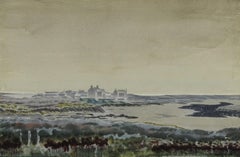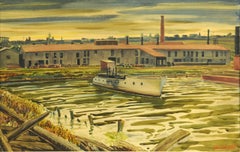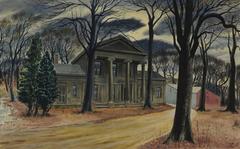Edward Dobrotka Art
to
2
1
2
1
1
Overall Height
to
Overall Width
to
1
1
1
1
1
1
2
2
2
6,952
3,302
2,514
1,213
2
2
Artist: Edward Dobrotka
Irish Sea
By Edward Dobrotka
Located in Fairlawn, OH
Irish Sea
Watercolor, 1947
Signed and dated by the artist lower right
Condition: Excellent
Image/Sheet size: 12 x 18 inches
Provenance: Estate of the Artist
...
Category
1940s American Realist Edward Dobrotka Art
Materials
Watercolor
Breaking Up of the Penelope
By Edward Dobrotka
Located in Fairlawn, OH
Breaking Up of the Penelope
watercolor on artists watercolor board, 1942
Signed and dated by the artist lower right (see photo)
Exhibitions:
Cleveland, OH, The Cleveland Museum of Art, May 3 - June 11, 1944: "The 26th Annual Ehibition of Works by Artists and Craftsmen of the Western Reserve," , (label on verso)
Youngstown OH, The Butler Insititue of American Art, 1943: "1943 New Year Show," , (label on verso)
"Ed Dobrotka was one of comic-book illustrator Joe Shuster's early assistants. In the studio, he worked on the 'Superman' series, inking the pencils of artists including Shuster, John Sikela, Leo Nowak and Wayne Boring.
Dobrotka did do some pencilling of his own, however he returned to inking exclusively in 1945. In the following years, he worked with Sikela on the 'Superboy' series until the 1950s. He has also work on the solo 'Lois Lane...
Category
1940s American Realist Edward Dobrotka Art
Materials
Watercolor
Related Items
Farm House, colorful 20th century American scene watercolor
By George Adomeit
Located in Beachwood, OH
George Gustav Adomeit (American, 1879-1967)
Farm House, Chagrin Falls, Ohio
Watercolor on paper
Signed lower right, handwritten artist and title label verso
12.5 x 18.75 inches
18 x 24.5 inches, framed
A major painter of American scene...
Category
20th Century American Realist Edward Dobrotka Art
Materials
Watercolor
“The Lobstermen”
By Gordon Grant
Located in Southampton, NY
Beautiful original watercolor and gouache on archival paper by the famous American marine artist, Gordon Grant. The artwork depicts two rugged lobstermen bringing their catch ashore...
Category
1930s American Realist Edward Dobrotka Art
Materials
Gouache, Watercolor, Archival Paper
"Going to the Festival" WPA Ashcan 20th Century American Scene Modern Realism
By Daniel Ralph Celentano
Located in New York, NY
"Going to the Festival" WPA Ashcan 20th Century American Scene Modern Realism
Daniel Celentano (1902 - 1980) "Going to the Festival," 14 1/2 x 10 1/2. Watercolor on paper, c. 1930s....
Category
1930s American Realist Edward Dobrotka Art
Materials
Paper, Watercolor
1960s "Mountain Side" Watercolor Landscape California Gold Country Mid Century
Located in Arp, TX
Thelma Corbin Moody
AbEx Mountain Side
c. 1960's
Watercolor on Arches Paper
29.5" x 22", Unframed
Thelma Corbin Moody (1908-1986) of Modesto, CA....
Category
Late 20th Century American Realist Edward Dobrotka Art
Materials
Watercolor, Paper
No Reserve
H 22 in W 29.5 in
TOBACCO ROAD Mid 20th Century Realism 1940 Drawing from the Novel WPA Literary 2
By David Fredenthal
Located in New York, NY
TOBACCO ROAD Mid 20th Century Realism 1940 Drawing from the Novel WPA Literary 2
10 1/2 x 6 (sight), Signed David Fredenthal lower right. Framed by Lowy....
Category
1930s American Realist Edward Dobrotka Art
Materials
Paper, Ink, Watercolor
H 21 in W 16 in D 2 in
"Waiting for Spring"
By Peter Sculthorpe
Located in Lambertville, NJ
Jim’s of Lambertville is proud to offer this artwork.
Signed lower left.
Complemented by a hand carved and gilt frame.
Peter Sculthorpe (b. 1948)
Peter Sculthorpe was born in ...
Category
21st Century and Contemporary American Realist Edward Dobrotka Art
Materials
Watercolor
San Gio, Como
By Eleanor Parke Custis
Located in New York, NY
Eleanor Park Custis painted scenes as varied as the artist's travels: from her hometown of Washington, D.C., to the coastal towns of New England; from the prosperous fishing villages of Brittany, to Venice and the mountain villages and lakes of northern Italy.
While Custis's subjects are diverse, her style is consistent and distinctive throughout this body of work. Her use of flat areas of color delineated by dark contours is reminiscent of the aesthetics of woodblock printing. Like many artists of the day, she was profoundly influenced by Japanese woodblock prints, and her adaptation of the aesthetic by 1924 led to her most productive artistic period.
Eleanor Custis hailed from a socially prominent Washington, D.C., family. She was distantly related to Martha Custis Washington, America's first First Lady. Custis began three years of formal art training in the autumn of 1915 at the Corcoran School of Art in Washington, and was guided and inspired by Impressionist artist Edmund C. Tarbell, one of the Ten American Painters, who became the Corcoran School's principal in 1918. Custis exhibited widely in many of the Washington art societies and clubs for much of her career. She was also a frequent exhibitor at the Grand Central Art Galleries in New York City; her last one-woman show there was in April 1945.
Custis's mature style emerged in scenes of the streets, wharves, and drydocks of seacoast villages from Maine to Massachusetts, which she visited during the summers of 1924 and 1925. She was working in Gloucester, Massachusetts in August 1924, and painted several gouaches of the town's wharves and winding streets, including In Gloucester Harbor and At the Drydock, Gloucester. During her stay, Custis may have met Jane Peterson or at least must have seen her work, the best of which was executed in Gloucester during the preceding ten years. The similarity between their styles is unmistakable, but, while it may be tempting to suggest that Custis was influenced by Peterson during her summer in Gloucester, the connection between their work is probably more a case of shared aesthetics and common European influences.
Custis expanded her subject repertoire with three trips to Europe between 1926 and 1929, and was inspired by the Old World charm of Holland, northern France, Switzerland, and Italy, leading to such works as New Kirk, Delft, Holland, Market Day in Quimper, At the Foot of the Matterhorn, and The Town Square, Varenna. A Mediterranean cruise in 1934 introduced her to the Near East, and the bustling, colorful streets and bazaars of Cairo, captured in works like A Street in Cairo, Egypt and A Moroccan Jug...
Category
20th Century American Realist Edward Dobrotka Art
Materials
Paper, Gouache
"Under the Beach Umbrella, " American Realist, Watercolor, Seaside, Figural
By Aaron Berkman
Located in Wiscasset, ME
Aaron Berkman was born in Hartford, Connecticut in 1900. In 1916 Berkman attended the Connecticut League of Art Students, founded by Charles Noel Flagg. Beginning in 1919 he studied under Albertus E. Jones at the Hartford Art School. Berkman was influenced during this time by George Inness and John Singer Sargent and the Old Masters. He received a scholarship to the Museum Art School of Boston in 1921 and then traveled to Europe, remaining there from 1924 through 1925. He spent time in France, Italy, Spain, Holland and Belgium. In 1929 Berkman moved to New York City, continuing a friendship and painting relationship with Milton Avery. He was appointed by the W.P.A. as Director of the WPA Art Center at the 92nd Street Y in New York City. Berkman helped established the A.C.A. Gallery in New York City at 52 West 8th St., the first Artist Cooperative Gallery in New York City. He spent summers on Monhegan Island in...
Category
20th Century American Realist Edward Dobrotka Art
Materials
Watercolor
Schooner St. Croix
By Emilio Sanchez
Located in New York, NY
Emilio Sanchez (1921-1999) created the watercolor entitled “Schooner St. Croix” in 1952. This piece is signed in pen at the lower right and titled on the verso. The paper size is 16.88 x 22.25 inches. Stamped on verso "Estate of Emilio Sanchez." Good to very good condition.
“Best known for his architectural paintings and lithographs, Emilio Sanchez (1921-1999) explored the effects of light and shadow to emphasize the abstract geometry of his subjects. His artwork encompasses his Cuban heritage...
Category
1950s American Realist Edward Dobrotka Art
Materials
Graphite, Watercolor
Bus Stop, New York City
By Don David
Located in Long Island City, NY
Artist: Don Davis
Title: Bus Stop
Medium: Watercolor on paper, signed lower right
Image Size: 27.5 x 19.5 inches
Frame Size: 35 x 27 inches
This watercolor by American artist Don Da...
Category
1980s American Realist Edward Dobrotka Art
Materials
Archival Paper, Watercolor
Shore, towards dusk, northeastern seascape watercolor
By Dozier Bell
Located in New York, NY
Dozier Bell’s paintings and intimate, diminutive charcoal drawings (some of which measure as small as 2 x 4 inches) bring to mind 19th-century American painters Albert Pinkham Ryder, R. A. Blakelock, Frederick Church...
Category
2010s American Realist Edward Dobrotka Art
Materials
Watercolor, Paper
Passaic Falls in New Jersey
By Nicolino V. Calyo
Located in New York, NY
Nicolino Calyo's career reflects a restless spirit of enterprise and adventure. Descended in the line of the Viscontes di Calyo of Calabria, the artist was the son of a Neapolitan army officer. (For a brief biographical sketch of the artist see Philadelphia Museum of Art, Pennsylvania, Philadelphia: Three Centuries of American Art, exhib. cat. [1976], pp. 299-301 no. 257.) Calyo received formal training in art at the Naples Academy. His career took shape amidst the backdrop of the political turbulence of early nineteenth-century Italy, Spain, and France. He fled Naples after choosing the losing side in struggles of 1820-21, and, by 1829, was part of a community of Italian exiles in Malta. This was the keynote of a peripatetic life that saw the artist travel through Europe, to America, to Europe again, and back to America.
Paradoxically, Calyo’s stock-in-trade was close observation of people and places, meticulously rendered in the precise topographical tradition of his fellow countrymen, the eighteenth-century
vedute painters Antonio Canale (called Canaletto) and Francesco Guardi. In search of artistic opportunity and in pursuit of a living, Calyo left Malta, and, by 1834, was in Baltimore, Maryland. He advertised his skills in the April 16, 1835 edition of the Baltimore American, offering "remarkable views executed from drawings taken on the spot by himself, . . . in which no pains or any resource of his art has been neglected, to render them accurate in every particular" (as quoted in The Art Gallery and The Gallery of the School of Architecture, University of Maryland, College Park, 350 Years of Art & Architecture in Maryland, exhib. cat. [1984], p. 35). Favoring gouache on paper as his medium, Calyo rendered faithful visual images of familiar locales executed with a degree of skill and polish that was second nature for European academically-trained artists. Indeed, it was the search for this graceful fluency that made American artists eager to travel to Europe and that led American patrons to seek out the works of ambitious newcomers.
On June 16, 1835, the Baltimore Republican reported that Calyo was on his way north to Philadelphia and New York to paint views of those cities. Calyo arrived in New York, by way of Philadelphia, just in time for the great fire of December 1835, which destroyed much of the downtown business district. He sketched the fire as it burned, producing a series of gouaches that combined his sophisticated European painting style with the truth and urgency of on-the-spot observation. Two of his images were given broad currency when William James Bennett reproduced them in aquatint. The New-York Historical Society owns two large Calyo gouaches of the fire, and two others, formerly in the Middendorf Collection, are now in the collection of Hirschl & Adler Galleries. From 1838 until 1855, Calyo listed himself variously in the New York City directories as a painter, a portrait painter, and as an art instructor, singly, and in partnership with his sons, John (1818-1893) and later, the younger Hannibal (1835-1883). Calyo also attracted notice for a series of scenes and characters from the streets of New York, called Cries of New York. These works, which were later published as prints, participate in a time-honored European genre tradition. Calyo’s New York home became a gathering place for European exiles, including Napoleon III. Between 1847 and 1852 Calyo exhibited scenes from the Mexican War and traveled from Boston to New Orleans with his forty-foot panorama of the Connecticut River. Later, he spent time in Spain as court painter to Queen Maria Christina, the result of his continuing European connections, but he was back in America by 1874, where he remained until his death.
The Passaic River rises in the hills just south of Morristown, New Jersey, marking a serpentine eighty-mile course before it empties into Newark Bay. It flows north-northeast to Paterson, where it falls seventy feet in a spectacular cataract before continuing south through Passaic and Newark. William Gerdts, in Painting and Sculpture in New Jersey (1964, pp. 51-2), describes the falls as:
the most important [landscape] subject in New Jersey during the eighteenth and nineteenth centuries. . . . The Passaic Falls remained a popular spot, particularly during the romantic period. Indeed, newspapers, periodicals, and gift books contain many accounts of visits to the Falls, sentimental poems written about them or about a loved one visiting the Falls, or even, occasionally, in memory of one who perished in the waters of the Falls — usually intentionally. . . . Waterfalls . . . were popular among travelers in the period and the Passaic Falls were only surpassed by Niagara Falls and Trenton Falls...
Category
19th Century American Realist Edward Dobrotka Art
Materials
Paper, Gouache
Previously Available Items
Arcady: Oswego - Ithaca Turnpike, New York State
By Edward Dobrotka
Located in Fairlawn, OH
Signed, titled, and dated by the artist lower right
Exhibitions:
Youngstown, OH, The Butler Insititute of American Art, 1946: "1946 New Year Show,",(label from verso of frame)
...
Category
1940s Edward Dobrotka Art
Materials
Watercolor
Edward Dobrotka art for sale on 1stDibs.
Find a wide variety of authentic Edward Dobrotka art available for sale on 1stDibs. You can also browse by medium to find art by Edward Dobrotka in paint, watercolor and more. Not every interior allows for large Edward Dobrotka art, so small editions measuring 18 inches across are available. Customers who are interested in this artist might also find the work of Gordon Grant, Don David, and David Fredenthal. Edward Dobrotka art prices can differ depending upon medium, time period and other attributes. On 1stDibs, the price for these items starts at $700 and tops out at $3,500, while the average work can sell for $2,100.




